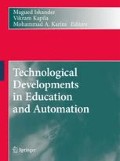Abstract
The designing tools for an e-learning system in the naval engineering are the argument of this paper. The field particularity, like variety and size of ship structures and piping have defined the methods and techniques for developing the specific components of the e-learning system, based mainly on the generation of animated virtual models. Therefore the creation of the necessary tools for a correct 3D perception of the ship and also the tools for self assessment and assessment are the main components for the present e-learning field. The efficient use of the e-learning tools is provided by the management of a unitary platform as an integrated e-learning system.
Testing and validation of the e-learning tools has been an important phase in implementing the educational system in the Naval Architecture Faculty of Galati.
Access this chapter
Tax calculation will be finalised at checkout
Purchases are for personal use only
Preview
Unable to display preview. Download preview PDF.
References
Beard, C. (2007) Experiential learning: The Development of a Framework for Effective Practice. Unpublished thesis, (PhD). Sheffield Hallam University.
Beard, C., Clegg, S. and Smith, K. (2007) Acknowledging the Affective in Higher Education. British Educational Research Journal,33(2), April, 235-252.
Beard, C. and McCarter, R. (2005) Mastering University. [CD-ROM]. Aldershot: Gower.
Beard, C. M. and Wilson, J. P. (2002) The Power of Experiential Learning: A Handbook for Educators and Trainers. London: Kogan Page.
Beard, C. and Wilson, J. P. (2005) Ingredients for Effective Experiential Learning: the learning combination lock. In: P. Hartley et al.(eds) Enhancing Teaching in Higher Education: New Approaches for Improving Student Learning. York: Routledge/Higher Education Academy, 3-15.
Beard, C. and Wilson, J.P. (2006) Experiential Learning: A Best Practice Handbook for Educators and Trainers. London: Kogan Page.
Clark, R. C. and Mayer, R. E. (2003) E-Learning and the Science of Instruction: Proven Guidelines for Consumers and Designers of Multi-media Learning. San Francisco CA: Jossey-Bass/Pfeiffer.
Collis, B. and Moonen, J. (2001) Flexible Learning in a Digital World: Experiences and xpectations. London: Kogan Page.
Beard, Wilson and McCarter (2007) Towards a Theory of e-Learning: Experiential e-Learning, Journal of Hospitality, Leisure, Sport and Tourism Education, Vol. 6, No. 2., www.heacademy.ac.uk/hlst/resources/johlste
Fenwick, T. J. (2003) Learning Through Experience: Troubling Orthodoxies and Intersecting Questions. Malabar, Florida: Krieger Publishing Company.
Hede, A. (2002) An Integrated Model of Multimedia Effects on Learning. Journal of Educational Multimedia and Hypermedia, 11 (2), 177-191.
McCarter, R. (2005) Analysing the pedagogical value of the synergy between video and text in a digital media application.Unpublished Masters Dissertation, Sheffield Hallam University.
Moreno, R., Mayer, R. E., Spires, H. A. and Lester, J. C. (2001) The Case for Social Agency in Computer-Based Teaching: do students learn more deeply when they interact with animated pedagogical agents? Cognition and Instruction,19(2), 177-213.
Mortiboys, A. (2002) The Emotionally Intelligent Lecturer. Birmingham: SEDA Publications.
Nichols, M. (2003) A Theory for ELearning. Educational Technology and Society,6(2), 1-10.
Payne, P. (2002) On the Construction, Deconstruction and Reconstruction of Experience in Critical Outdoor Education. Australian Journal of Outdoor Education,6(2), 4-21.
Ravenscroft, A. (2001) Designing ELearning Interactions in the 21stCentury: revisiting and rethinking the role of theory. European Journal of Education,36(2), 133-156.
Robertson, I. (2000) Mind Sculpture: Your Brain’s Untapped Potential. London: Bantam Books.
Schoenmaker, J. and Stanshev, I. (2000) Visualisation, Principles and Tools for Instructional Visualisation. University of Twente: Andersen Consulting-ECC.
Sherry, L. (2003) Issues in Distance Learning. International Journal of Educational Telecommunications,1(4), 337-365.
Author information
Authors and Affiliations
Corresponding author
Editor information
Editors and Affiliations
Rights and permissions
Copyright information
© 2010 Springer Science+Business Media B.V.
About this paper
Cite this paper
Popescu, G. (2010). E-learning Tools in Naval Engineering. In: Iskander, M., Kapila, V., Karim, M. (eds) Technological Developments in Education and Automation. Springer, Dordrecht. https://doi.org/10.1007/978-90-481-3656-8_97
Download citation
DOI: https://doi.org/10.1007/978-90-481-3656-8_97
Published:
Publisher Name: Springer, Dordrecht
Print ISBN: 978-90-481-3655-1
Online ISBN: 978-90-481-3656-8
eBook Packages: Humanities, Social Sciences and LawEducation (R0)

